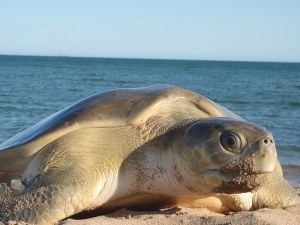Room to move
Research news
With the help of advanced satellite tracking systems, Deakin researchers have been able to track vulnerable flatback sea turtles along their migratory routes - and confirm the importance of Australia’s newly-established network of marine parks.
Researchers from Deakin, Swansea University (UK) and Pendoley Environmental consultancy recorded the passage of more than 70 flatbacks off the north-west Australian coastline.
They were able to identify a high value migratory corridor, more than 1,000 kilometres in length, of which about half was contained within the network of Australian marine reserves that was consolidated in 2012.
“Our findings show that much of the flatback turtle’s transit passage – between its breeding colonies and foraging grounds – falls within the newly-established Commonwealth Marine Reserve network,” said animal movement expert Professor Graeme Hays, from Deakin’s School of Life and Environmental Sciences.
“These findings will help us to refine ongoing conservation planning to protect this wide-ranging turtle species, including the identification of high use areas outside the existing reserve network.”
Professor Hays explained that the migration corridor lies close to the Australian mainland and is more than 1000km long and a few tens of kilometres in width. It is believed that the turtles, which live for up to 50 years, migrate along the same routes between areas along the north-west coast of Australia, where they nest, to areas as far as New Guinea each year.
The flatback and other marine species in the area may be susceptible to accidents, such as through collision with vessels or as fishery bycatch, or they are prey to other animals, such as dingos and foxes, when they are nesting on land.
Tracking devices were attached to each turtle’s soft shell, using a flexible harness that detached after about 12 months of use. A signal that showed the turtle’s position was transmitted in real-time to a group of satellites known as the ‘Argos system’ as the animals surfaced to breathe - about once every 10 to 15 minutes.
The research, published this week in Marine Biology, also highlights how whales, sharks and turtles share a common migration corridor, which was previously unknown.
"We hope that the network of Australian marine reserves could serve as a template for marine conservation elsewhere in the world,” he said.
Share this story
 The flatback sea turtle.(Photo credit: Pendoley Environmental)
The flatback sea turtle.(Photo credit: Pendoley Environmental)
